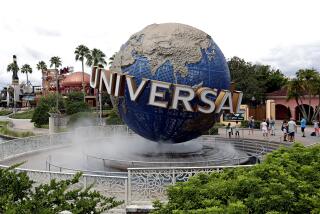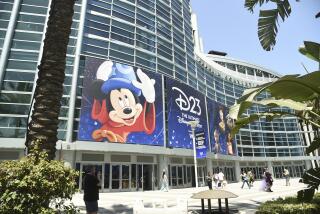Where Theme Parks Go for Fun
- Share via
ORLANDO, Fla. — At this amusement park for amusement park operators, you can see a grown man ride a stuffed ostrich. You can sample glow-in-the-dark flavored ice sticks. And you can take a spin on a state-of-the-art, million-dollar roller coaster -- then buy it.
Deals big and small are negotiated at the annual trade show for the $19-billion industry. The newest rides are unveiled, and vendors peddle everything from soft pretzels to bumper cars. It’s an overload of sights and sounds -- a carnival on steroids.
“Ten miles of aisles!” declared Beth Robertson, spokeswoman for the International Assn. of Amusement Parks and Attractions, navigating the million-square-foot trade show in a business suit and a pair of sneakers, map in hand.
“This truly is where business happens,” Robertson said of this world’s largest amusement park trade show, with 30,000 attendees from 80 countries. The show ends Saturday.
Among the exhibitors, along with people pitching penny-press machines and outdoor stereo systems, is the city of Garden Grove. Its representatives are there to tell amusement park developers that there’s land just down the street from Disneyland begging to become a tourist mecca.
Other exhibitors, such as Jim Clark, a.k.a. PopNGlow Man, have different visions. In a fit of marketing genius, he combined an ice pop with a specially made, cold-formula glow stick. The result? Lick ‘em Lights.
“They eat it,” said Clark, “then they have something to play with.”
Judging by the long line of conventioneers outside his booth, he figures by next year his cold creations will be real hot. But then he’s competing with “cool dogs,” ice cream sundaes in hot dog bun-shaped sponge cake, and chocolate-dipped Key lime pie on a stick. Since taking his Key West creation national, Jeffrey Rowe said he’s gone from hand-dipping 400 pieces of the tart pie daily to mass producing and shipping 40,000 a day. In the first two days of the trade show, he took orders for more than a million.
Many of the 1,260 exhibitors agree that for anyone in the business, this trade show is where the action is. Even people who aren’t exactly in the business, but trying to break in, know that.
That explains the presence of Garden Grove, which has no connection to amusement parks other than its proximity to Disneyland. City officials are hoping to exploit their neighbor and build their own theme park and more hotels in an entertainment and retail zone they have dubbed International West.
“We’re unique,” said Glen Krieger, the city’s economic development director. “We’re the only city here. We’re the only ones trying to promote a specific place for development.”
Flanked by maps, artist renderings, logos for their big-city dream and a huge bowl of Starbursts to lure prospective investors and developers, eager city officials answered questions and handed out brochures.
The city’s booth, next to some aerial acrobats, wasn’t the sexiest at the show, but Krieger was upbeat. “We’ve gotten a lot of leads,” he said. “It’s been productive.”
Nearby, Layton Dodson, vice president of sales and marketing for United Receptacles, was struggling for business. “It’s hard to get people’s attention on trash cans,” he said. “But every park needs them, and they all use them.”
There were people pitching park benches and mulch, ticket machines and turnstiles, fake trees and plush midway prizes.
But most of the excitement centered around the attractions.
LeRue Jordan was selling $15,000 bull-riding simulators for Vast Integrated Visions, which also sells just about anything that can be inflated, including sumo suits, slides and giant beer bottles.
For added sales pizazz, Jordan hired real cowboys with tight Wranglers, silver belt buckles the size of grapefruits and South Carolina drawls.
KUKA, a German manufacturer, was pushing Robocoaster, a free-standing, trackless, two-seat ride on a robotic arm that whips people up, down, around and upside-down. Yours for $300,000.
So far, there are only two Robocoasters in the United States -- at parks in Wisconsin and Michigan. But the company, which normally builds robots for auto assembly lines and surgery, plans a next-generation version for a traditional coaster track and incorporate virtual reality.
At the Garden Grove booth, the marketing team kept pushing Starbursts, disappointed that it wasn’t planted in an area with architects and consultants.
But being alongside the aerial performers, City Councilman Mark Rosen said, “at least we’re being entertained.”
More to Read
Sign up for The Wild
We’ll help you find the best places to hike, bike and run, as well as the perfect silent spots for meditation and yoga.
You may occasionally receive promotional content from the Los Angeles Times.







